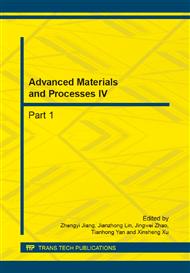p.408
p.413
p.417
p.422
p.427
p.431
p.439
p.443
p.447
Mechanical Properties of Fumed Silica / HDPE Composites
Abstract:
Fumed silica /High density Polyethylene (HDPE) composites were prepared via melt mixing using a two –screw co-rotating extruder. To improve the dispersion degree of the fumed silica, the γ-aminopropyl triethoxy silane (KH-550) was used as silane coupling agent. The composites which obstained different fumed silica content were prepared by melt-mixing process. Next composites mechanical properties were measured by the crystal polarized light microscopy (PLM), Shore hardness, the tensile testing. The results indicate that fumed silica can enhance HDPE resin and the mechanical properties of composites are optimum when fumed silica content is 3.0 wt%.
Info:
Periodical:
Pages:
427-430
Citation:
Online since:
September 2014
Authors:
Keywords:
Price:
Сopyright:
© 2014 Trans Tech Publications Ltd. All Rights Reserved
Share:
Citation:


